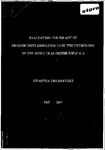EVALUATING THE IMPACT OF ORGANIC CONTAMINATION UPON THE PHYSIOLOGY OF THE SHORE CRAB Carcinus maenas (L.)
| dc.contributor.author | DISSANAYAKE, AWANTHA | |
| dc.contributor.other | Faculty of Science and Engineering | en_US |
| dc.date.accessioned | 2012-08-06T08:33:04Z | |
| dc.date.available | 2012-08-06T08:33:04Z | |
| dc.date.issued | 2007 | |
| dc.identifier | Not available | en_US |
| dc.identifier.uri | http://hdl.handle.net/10026.1/1113 | |
| dc.description.abstract |
This thesis has focused on answering fundamental questions regarding the 'normal' physiological ranges of the male shore crab Carcinus maenas. knowledge of the responses to environmental variables is needed before the effects of anthropogenic stress can be identified. Anthropogenic stress was imposed in the form of contamination by a ubiquitous priority pollutant of the aquatic environment (polyaromatic hydrocarbon, pyrene). The first hypothesis focused on identifying the physiological differences between juvenile and adult male shore crabs. Differences at the cellular level (cell and immune function) determined the relative contaminant sensitivity between the two ontogenetic stages, with juveniles expressing increased physiological sensitivity to contaminant-imposed effects compared to adults. Further questions relating to how the physiological condition of Carcinus maenas was altered by nutritional stress were examined in the adult stage. Physiological 'competency* or tolerance was shown to be dependent upon organism nutritional status. Shore crab physiological condition was robust to short-tenn starvation. This is interpreted to resultfrom autophagy induction, whereby, when diet is restricted, energy is released via metabolism of protein, carbohydrate and lipid stores. The physiological implications of sublethal contaminant exposure under short-temi induction included'increased antioxidant status, signalling activation of compensatory mechanisms under contaminant-mediated challenge. The behavioural implications of nutritional status and contaminant exposure were investigated by staging intraspecific agonistic contests between pairs of shore crabs for a food resource. Behavioural evidence revealed that the competitive ability (resource holding potential) of individuals was higher in pyrene-exposed compared to unexposed crabs, with higher proximate associated costs (energy expenditure) of entering agonistic contests in starved compared to fully-fed individuals. Shore crab competitive ability was concluded to be dependent upon the physiological condition of the contestant. The final hypothesis investigated 'seasonal' differences in the physiology of Carcinus maenas to test whether there were any 'windows of sensitivity' to both environmental and contaminant-imposed challenges. The 'normal' pattern of seasonal variability was assessed from crabs collected from the Avon Estuary. Differences included higher imhiune function and lower antioxidant status between winter and spring compared to summer to autumn. These seasonal differences were shown to impact on the ability of shore crabs to respond to PAH exposure. Seasonal evaluation of shore crab physiological condition from estuaries of varying PAH input [Avon Estuary (low anthropogenic exposure) and Plym Estuary (relatively high anthropogenic exposure)], revealed significant seasonal differences between crabs as signalled by cellular endpoints (cellular integrity and viability) between January and June compared to July to December. In summary, this study has revealed that shore crab physiology varies with intrinsic (age, nutritional status) and extrinsic (temperature) factors. Therefore, it is essential to establish the full extent of the 'normal' physiological ranges for C. maenas physiology to completely understand the impact of environmental and anthropogenic stress alike. | en_US |
| dc.language.iso | en | en_US |
| dc.publisher | University of Plymouth | en_US |
| dc.title | EVALUATING THE IMPACT OF ORGANIC CONTAMINATION UPON THE PHYSIOLOGY OF THE SHORE CRAB Carcinus maenas (L.) | en_US |
| dc.type | Thesis | |
| dc.identifier.doi | http://dx.doi.org/10.24382/4708 |
Files in this item
This item appears in the following Collection(s)
-
01 Research Theses Main Collection
Research Theses Main


